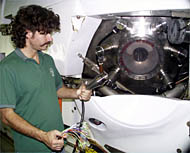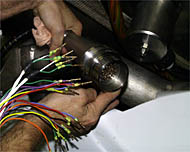East
Pacific Rise
Expedition 2:
Jan 27–Feb 8, 2000
Mission & Objectives
Daily Updates
Mail Buoy
Scientists & Crew
Interviews
Slideshows
Videos
Glossary

|
| Daily Updates: January |
| S |
M |
T |
W |
T |
F |
S |
| 23 |
24 |
25 |
26 |
27 |
28 |
29 |
| 30 |
31 |
|
|
|
|
|
| Daily Updates: February |
| S |
M |
T |
W |
T |
F |
S |
|
|
1 |
2 |
3 |
4 |
5 |
| 6 |
7 |
8 |
9 |
10 |
11 |
12 |


TODAY'S WEATHER
Broken
Clouds
79°F (26.1°C)
Latitude:
9 deg 49’N
Longitude: 104 deg 17’W
Wind Direction: NE
Wind Speed: 17 Knots
Sea
State: 3Swell(s)
Height: 2 Feet
Sea
Temperature: 82°F (27.8°C)
Barometric
Pressure: 1012.5 MB
Visibility: 20 Nautical Miles

Breakfast
Lox, cream cheese, and bagels
Cheddar cheese omelets
Fresh fruit
Sausages
Lunch
Turkey and cheese club sandwiches
Pasta salad
Salad bar
Onion rings
Dinner
Italian Night!
Antipasto (salads, salami, olives, beets)
Pasta with three sauces
Basil and Spinach Pesto
Spicy Marinara
Sausage and Vegetables
Homemade Garlic and Italian Bread
Ricotta Cheesecake
Deeper Discovery
Click
here for examples of digital photographs taken by the Towed Camera
Sled.
Daily Update: Dive 3526
February 1, 2000
By Dr. Dan Fornari
The Towed Camera Sled was brought on board early
this morning at 0530 because we had to transit about 13 miles
north for today’s dive. Pat Hickey will be the pilot for
today’s dive along with observers Bob James and Gary Comer.
They have a full program of hydrothermal vent mapping and fluid
sampling, as well as taking digital video of different volcanic
and vent features so that we can illustrate our drawings for
our science papers and the web site. This area has many hydrothermal
vents, black smokers, and biological communities which have been
studied since the 1991 volcanic eruption which took place on
the East Pacific Rise crest near 9° 50’N Latitude.
The camera worked very well for 7 hours on the bottom, then the battery power
gave out. Dan helped Greg, Del and Jenny in trying to figure out how to get more
power out of the batteries. We think that maybe they are not being charged enough,
so we gave them an 11-hour charge today and hopefully tonight the tow will last
longer.
More photos from Camera Tow #2 are posted as a slide show today
along with a map showing where the tow was.
This morning Dan Fornari spoke with the Science Club
of the Paul Revere School in Chicago. Gary Comer has been very
active at this school, which is where he attended elementary school.
He has helped them establish a science club and has provided computer
infrastructure and facilities for students and teachers. Dan answered
questions from the students while Gary was in Alvin. The
students had lots of questions for Gary and he will answer them
by email tomorrow. Some pictures of Gary are included in today’s
slideshow, including the ones requested by the kids! Don’t
miss them.
Mid-morning was interrupted by some problems just as Alvin was
approaching the bottom. When the sub was only 100 meters from the
bottom, Pat noticed that he had a ground in one of the electrical
lines that came from one of the main batteries.
When a piece of equipment becomes grounded, the electricity
no longer flows through it correctly. Instead of staying in the
wires, electricity gets out where the equipment is plugged in or,
in the case of equipment on Alvin,
into the pressure housing (the titanium metal case that protects
the wires and components from the pressure in the deep ocean). Grounds
allow the electrons holding together the atoms of metal in the electrical
wires to “float” away into the ocean. *Click
here for information about electrical grounds in Alvin written
by BLee Williams
BLee Williams, the Head of the Electrical
Team, Dave Olds and Bob Waters, the other electricians, talked
to Pat on the underwater telephone and worked with him to try to
isolate the ground. After about 30 minutes of discussion and testing,
they decided that Alvin had
to come back to the surface in order to fix the ground. After Alvin was
recovered, Bob Waters sprayed saltwater all over the different
penetrators and wires in Alvin to help locate the ground
while Pat tested the electrical lines inside Alvin. It took
them only an hour to discover that a few drops of water had seeped
into one of Alvin's penetrators. Penetrators allow wires to pass
into the Alvin pressure sphere - where the people sit. Penetrators
are very specialized pieces of equipment. They have to fit perfectly
into Alvin’s hull and not let ANY water in. Alvin has
very sophisticated detectors all around the sub to warn the pilot
if there is even a tiny drop of water anywhere in the electrical
system. All the Alvin crew pitched in and fixed the penetrator
and prepared the sub for another dive tomorrow. Bob and Gary will
go down tomorrow to the vents with BLee Williams as pilot.
After lunch, Sam Dean of COSI - the Center of Science and Industry in Columbus
and Toledo, Ohio, gave a lecture on some of the educational and outreach activities
that COSI is involved in. Woods Hole Oceanographic Institution and COSI are
collaborating on education and public awareness programs based around the Dive
and Discover web site. At the end of his lecture, Sam also handed out some
funny “Noise Putty”. This stuff smells very sweet, but the neat
thing about it is when you stick your fingers in it makes silly noises. Everyone
enjoyed playing with it!
The rest of the afternoon was spent analyzing the gravity and magnetics data
from the first two dives.
Jim, Dana, Hans and Dan are working hard
to make sure that all the information they are collecting
is precise. They are also writing instructions for
the next group of observers so that they can operate
all the geophysical equipment installed on Alvin.
Dan took some time off to cook his Italian specialties for tonight’s dinner
for all of the crew and scientists on board. Others took time off for a dip in
the pool, or to work out with Tim McGee who lead a Navy SEAL exercise program
on the bow.
Dive Summary
On Bottom: 0914 hours
Off Bottom: 0945 hours
Maximum Depth: 2534 meters
The dive today did not traverse the seafloor due to a ground. Tomorrow’s
dive will carry out the science program which was supposed to be done today.
Keeping
The “Big O“ Out of Alvin
By BLee Williams |
 |
| BLee Williams holding
one of Alvin's penetrators. These penetrators
are located around the viewports and are where wires
from outside of Alvin's sphere come inside the
sub. |
Submarine
are often called “electric boats” because they
need lights and power to see and move, computers to log data,
and sensors to measure temperature and pressure. Add to that
the manipulation capabilities and the needs of the scientific
equipment that Alvin uses, and you can see why Alvin needs
electricity to operate.
Understanding how electricity can be safely used in the “Big O”,
as submariners sometimes call the ocean, is one of the first and most important
lessons a new submariner learns. Seawater is able to conduct electricity
very easily. Very pure water will not conduct electricity, but if you add
salt to it, then electricity will pass through it because of the dissolved
salt. The electrical energy to run Alvin and all its tools is stored
in big batteries made up from lots of high-power golf cart batteries (see
the Interview with BLee Williams - Alvin’s chief electrician
and the person responsible for its batteries). It is very important
that the energy stored in these batteries is not allowed to ’leak’ out
of Alvin. Apart from wasting precious power and not being able to
complete all the science planned for a dive, leaking power causes damage
to equipment.
Electricians call leaking power a “ground”. When a piece of
equipment becomes grounded, the electricity no longer flows through it
correctly. Instead of staying in the wires, electricity gets out where
the equipment is plugged in or, in the case of equipment on Alvin,
into the pressure housing (the titanium metal case that protects the wires
and components from the pressure in the deep ocean). These grounds allow
the electrons holding together the atoms of metal in the electrical wires
to “float” away into the ocean. If the ground is bad enough,
or is left uncorrected, the metal actually begins to disappear as the bonds
holding the atoms together are removed. This is called “corrosion”.
Pretty soon, the wire disappears and electrons can no longer move along
it. This could lead to electrical connectors failing and could let seawater
into pressure housings or even the Alvin personnel sphere.
 |
| A
close-up view of one of Alvin's penetrators. |
Grounded
equipment does not work properly, so sensitive instruments that rely
on electricity from Alvin’s batteries need that power
to be good, or “clean” as electricians call it. Alvin’s electrical
team (ETeam) is primarily responsible for the sub’s electrical
systems and testing for grounds on all its permanent equipment, as
well as additional equipment that different scientists bring out
to do their experiments. The ETeam inspects Alvin’s electrical
system for grounds before and after every dive. During the dives,
the pilots check for grounds frequently. Equipment that becomes grounded
is never operated. Even a “little” ground on a piece
of electronics is not “good enough”; it is either not
grounded or it is not used.
I tell new members of the Alvin Group: “It’s nice to
love the sea, but a healthy respect for the awesome power of the water
is what will keep you alive”. Keeping track of grounds and where
electricity is flowing in Alvin is important when working in the “Big
O”. |
|






